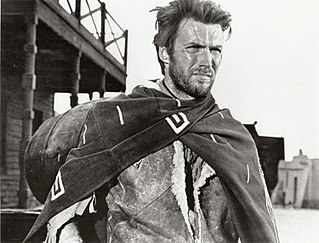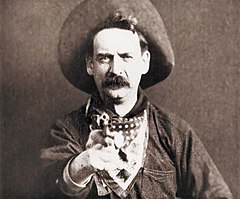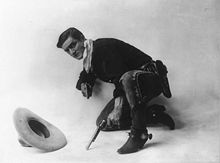
A film genre is a stylistic or thematic category for motion pictures based on similarities either in the narrative elements, aesthetic approach, or the emotional response to the film.

The spaghetti Western is a broad subgenre of Western films produced in Europe. It emerged in the mid-1960s in the wake of Sergio Leone's filmmaking style and international box-office success. The term was used by foreign critics because most of these Westerns were produced and directed by Italians.

The gunfight at the O.K. Corral was a gunfight that lasted less than a minute between lawmen led by Virgil Earp and members of a loosely organized group of outlaws called the Cowboys that occurred at about 3:00 p.m. on Wednesday, October 26, 1881, in Tombstone, Arizona Territory, United States. It is generally regarded as the most famous gunfight in the history of the American Old West.

The American frontier, also known as the Old West, and popularly known as the Wild West, encompasses the geography, history, folklore, and culture associated with the forward wave of American expansion in mainland North America that began with European colonial settlements in the early 17th century and ended with the admission of the last few contiguous western territories as states in 1912. This era of massive migration and settlement was particularly encouraged by President Thomas Jefferson following the Louisiana Purchase, giving rise to the expansionist attitude known as "manifest destiny" and historians' "Frontier Thesis". The legends, historical events and folklore of the American frontier have embedded themselves into United States culture so much so that the Old West, and the Western genre of media specifically, has become one of the defining features of American national identity.

Gunfighters, also called gunslingers, or in the late 19th and early 20th century, gunmen were individuals in the American Old West who gained a reputation of being dangerous with a gun and participated in shootouts. Today, the term "gunslinger" is more or less used to denote someone who is quick on the draw with a handgun, but this can also refer to those armed with rifles and shotguns. The gunfighter is also one of the most popular characters in the Western genre and has appeared in associated films, television shows, video games, and literature.

Western fiction is a genre of literature set in the American Old West frontier and typically set from the late eighteenth to the late nineteenth century. Well-known writers of Western fiction include Zane Grey from the early 20th century and Louis L'Amour from the mid-20th century. The genre peaked around the early 1960s, largely due to the popularity of televised Westerns such as Bonanza. Readership began to drop off in the mid- to late 1970s and reached a new low in the 2000s. Most bookstores, outside a few west American states, only carry a small number of Western fiction books.
Western music is a form of music composed by and about the people who settled and worked throughout the Western United States and Western Canada. Western music celebrates the lifestyle of the cowboy on the open range, along the Rocky Mountains, and among the prairies of Western North America. The genre grew from the mix of cultural influences in the American frontier and what became the Southwestern United States at the time, it came from the folk music traditions of those living the region, those being the hillbilly music from those that arrived from the Eastern U.S., the corrido and ranchera from Northern Mexico, and the New Mexico and Tejano endemic to the Southwest. The music industry of the mid-20th century grouped the western genre with that of similar folk origins, instrumentation and rural themes, to create the banner of country and western music, which was simplified in time to country music.

A science fiction Western is a subgenre or cross-genre that uses traditional Western plots and settings, while incorporating science fiction elements such as futuristic technology or aliens. The post-apocalyptic Western and steampunk Western fall within this subgenre.

Bass Reeves was a runaway slave, gunfighter, farmer, scout, tracker, railroad Agent and deputy U.S. Marshal. He spoke and understood the Five Civilized Tribal languages including Cherokee, Choctaw, Chickasaw, Seminole and Creek. Bass was one of the first African-American Deputy U.S. Marshals west of the Mississippi River, mostly working in the deadly Indian Territory. The region was saturated with horse thieves, cattle rustlers, gunslingers, bandits, bootleggers, swindlers, and murderers. Reeves made more than 3,000 to 4,000 arrests in his lifetime, only killing twenty men in the line of duty.

Weird West is a term used for the hybrid genres of fantasy Western, horror Western and science fiction Western. The term originated with DC's Weird Western Tales in 1972, but the idea is older as the genres have been blended since the 1930s, possibly earlier, in B-movie Westerns, comic books, movie serials and pulp magazines. Individually, the hybrid genres combine elements of the Western genre with those of fantasy, horror and science fiction respectively.

Space Western is a subgenre of science fiction that uses the themes and tropes of Westerns within science-fiction stories in an outer space setting. Subtle influences may include exploration of new, lawless frontiers, while more overt influences may feature literal cowboys in outer space who use rayguns and ride robotic horses. Although initially popular, a strong backlash against perceived hack writing caused the genre to become a subtler influence until the 1980s, when it regained popularity. A further critical reappraisal occurred during the 2000s due to critical acclaim for Firefly.

Television Westerns are programs with settings in the later half of the 19th century in the American Old West, Western Canada and Mexico during the period from about 1860 to the end of the so-called "Indian Wars". More recent entries in the Western genre have used the neo-Western subgenre, placing events in the modern day, or the space Western subgenre but still draw inspiration from the outlaw attitudes prevalent in traditional Western productions.

A dime Western is a modern term for Western-themed dime novels, which spanned the era of the 1860s–1900s. Most would hardly be recognizable as a modern western, having more in common with James Fennimore Cooper's Leatherstocking saga, but many of the standard elements originated here: a cool detached hero, a frontiersman, a fragile heroine in danger of the despicable outlaw, savage Indians, violence and gunplay, and the final outcome where Truth and Light wins over all. Often real characters — such as Buffalo Bill or the famous Kit Carson — were fictionalized, as were the exploits of notorious outlaws such as Billy the Kid and Jesse James. Buffalo Bill's literary incarnation provides the transition from the frontier tales to the cowboy story, as he straddles both of the genres.

The Northern or Northwestern is a genre in various arts that tell stories set primarily in the late 19th or early 20th century in the north of North America, primarily in western Canada but also in Alaska. It is similar to the Western genre, but many elements are different, as appropriate to its setting. It is common for the central character to be a Mountie instead of a cowboy or sheriff. Other common characters include fur trappers and traders, lumberjacks, prospectors, First Nations people, settlers, and townsfolk.

Western comics is a comics genre usually depicting the American Old West frontier and typically set during the late nineteenth century. The term is generally associated with an American comic books genre published from the late 1940s through the 1950s. Western comics of the period typically featured dramatic scripts about cowboys, gunfighters, lawmen, bounty hunters, outlaws, and Native Americans. Accompanying artwork depicted a rural America populated with such iconic images as guns, cowboy hats, vests, horses, saloons, ranches, and deserts, contemporaneous with the setting.

Warlock is a Western novel by the American author Oakley Hall, first published in 1958. The story is set in the early 1880s, in a fictional southwestern mining town called Warlock and its vicinity. The novel's characters and many elements of its plot are loosely based on actual people and events from Tombstone, Arizona during the same time period, including Wyatt Earp and the Gunfight at the O.K. Corral. It has been described as a precursor to, or early example of, the revisionist western, due to its moral ambiguity and satirical commentary on Cold-War-era American society. The novel was a finalist for the 1958 Pulitzer Prize.

Wyatt Earp was an American Old West lawman and gambler in Cochise County, Arizona Territory, and a deputy marshal in Tombstone, Arizona Territory.

Western romance literature denotes a genre subset of romance literature, sometimes referred to as cowboy romance. Works within this category typically adhere to the characteristics of romance but take place in a western setting, frequently the American frontier. Though often historical, the genre is not restricted to romantic works set in the period of American settlement but extends to contemporary romantic works that centre around cowboys or other tropes of the Western genre.

The Western is a film genre defined by the American Film Institute as films which are "set in the American West that [embody] the spirit, the struggle, and the demise of the new frontier." Generally set in the American frontier between the California Gold Rush of 1849 and the closing of the frontier in 1890, the genre also includes many examples of stories set in locations outside the frontier – including Northern Mexico, the Northwestern United States, Alaska, and Western Canada – as well as stories that take place before 1849 and after 1890. Western films comprise part of the larger Western genre, which encompasses literature, music, television, and plastic arts.
















